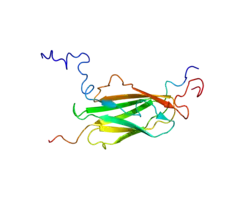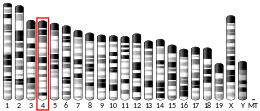FBLIM1
Filamin-binding LIM protein 1 is a protein that in humans is encoded by the FBLIM1 gene.[5][6][7]
| FBLIM1 | |||||||||||||||||||||||||||||||||||||||||||||||||||
|---|---|---|---|---|---|---|---|---|---|---|---|---|---|---|---|---|---|---|---|---|---|---|---|---|---|---|---|---|---|---|---|---|---|---|---|---|---|---|---|---|---|---|---|---|---|---|---|---|---|---|---|
 | |||||||||||||||||||||||||||||||||||||||||||||||||||
| |||||||||||||||||||||||||||||||||||||||||||||||||||
| Identifiers | |||||||||||||||||||||||||||||||||||||||||||||||||||
| Aliases | FBLIM1, CAL, FBLP-1, FBLP1, filamin binding LIM protein 1 | ||||||||||||||||||||||||||||||||||||||||||||||||||
| External IDs | OMIM: 607747 MGI: 1921452 HomoloGene: 56774 GeneCards: FBLIM1 | ||||||||||||||||||||||||||||||||||||||||||||||||||
| |||||||||||||||||||||||||||||||||||||||||||||||||||
| |||||||||||||||||||||||||||||||||||||||||||||||||||
| |||||||||||||||||||||||||||||||||||||||||||||||||||
| |||||||||||||||||||||||||||||||||||||||||||||||||||
| |||||||||||||||||||||||||||||||||||||||||||||||||||
| Wikidata | |||||||||||||||||||||||||||||||||||||||||||||||||||
| |||||||||||||||||||||||||||||||||||||||||||||||||||
This gene encodes a protein with an N-terminal filamin-binding domain, a central proline-rich domain, and, multiple C-terminal LIM domains. This protein localizes at cell junctions and may link cell adhesion structures to the actin cytoskeleton. This protein may be involved in the assembly and stabilization of actin-filaments and likely plays a role in modulating cell adhesion, cell morphology and cell motility. This protein also localizes to the nucleus and may affect cardiomyocyte differentiation after binding with the CSX/NKX2-5 transcription factor. Alternative splicing results in multiple transcript variants encoding different isoforms.[7]
References
- GRCh38: Ensembl release 89: ENSG00000162458 - Ensembl, May 2017
- GRCm38: Ensembl release 89: ENSMUSG00000006219 - Ensembl, May 2017
- "Human PubMed Reference:". National Center for Biotechnology Information, U.S. National Library of Medicine.
- "Mouse PubMed Reference:". National Center for Biotechnology Information, U.S. National Library of Medicine.
- Tu Y, Wu S, Shi X, Chen K, Wu C (April 2003). "Migfilin and Mig-2 link focal adhesions to filamin and the actin cytoskeleton and function in cell shape modulation". Cell. 113 (1): 37–47. doi:10.1016/S0092-8674(03)00163-6. PMID 12679033. S2CID 15051526.
- Takafuta T, Saeki M, Fujimoto TT, Fujimura K, Shapiro SS (March 2003). "A new member of the LIM protein family binds to filamin B and localizes at stress fibers". J Biol Chem. 278 (14): 12175–81. doi:10.1074/jbc.M209339200. PMID 12496242.
- "Entrez Gene: FBLIM1 filamin binding LIM protein 1".
- Tu, Yizeng; Wu Shan; Shi Xiaohua; Chen Ka; Wu Chuanyue (April 2003). "Migfilin and Mig-2 link focal adhesions to filamin and the actin cytoskeleton and function in cell shape modulation". Cell. United States. 113 (1): 37–47. doi:10.1016/S0092-8674(03)00163-6. ISSN 0092-8674. PMID 12679033. S2CID 15051526.
- Takafuta, Toshiro; Saeki Mari; Fujimoto Tetsuro-Takahiro; Fujimura Kingo; Shapiro Sandor S (April 2003). "A new member of the LIM protein family binds to filamin B and localizes at stress fibers". J. Biol. Chem. United States. 278 (14): 12175–81. doi:10.1074/jbc.M209339200. ISSN 0021-9258. PMID 12496242.
Further reading
- Wu C (2005). "Migfilin and its binding partners: from cell biology to human diseases". J. Cell Sci. 118 (Pt 4): 659–64. doi:10.1242/jcs.01639. PMID 15701922.
- Strausberg RL, Feingold EA, Grouse LH, et al. (2003). "Generation and initial analysis of more than 15,000 full-length human and mouse cDNA sequences". Proc. Natl. Acad. Sci. U.S.A. 99 (26): 16899–903. Bibcode:2002PNAS...9916899M. doi:10.1073/pnas.242603899. PMC 139241. PMID 12477932.
- Ota T, Suzuki Y, Nishikawa T, et al. (2004). "Complete sequencing and characterization of 21,243 full-length human cDNAs". Nat. Genet. 36 (1): 40–5. doi:10.1038/ng1285. PMID 14702039.
- Akazawa H, Kudoh S, Mochizuki N, et al. (2004). "A novel LIM protein Cal promotes cardiac differentiation by association with CSX/NKX2-5". J. Cell Biol. 164 (3): 395–405. doi:10.1083/jcb.200309159. PMC 2172236. PMID 14757752.
- Brandenberger R, Wei H, Zhang S, et al. (2005). "Transcriptome characterization elucidates signaling networks that control human ES cell growth and differentiation". Nat. Biotechnol. 22 (6): 707–16. doi:10.1038/nbt971. PMID 15146197. S2CID 27764390.
- Gerhard DS, Wagner L, Feingold EA, et al. (2004). "The Status, Quality, and Expansion of the NIH Full-Length cDNA Project: The Mammalian Gene Collection (MGC)". Genome Res. 14 (10B): 2121–7. doi:10.1101/gr.2596504. PMC 528928. PMID 15489334.
- Gkretsi V, Zhang Y, Tu Y, et al. (2005). "Physical and functional association of migfilin with cell-cell adhesions". J. Cell Sci. 118 (Pt 4): 697–710. doi:10.1242/jcs.01638. PMID 15671069.
- Rual JF, Venkatesan K, Hao T, et al. (2005). "Towards a proteome-scale map of the human protein-protein interaction network". Nature. 437 (7062): 1173–8. Bibcode:2005Natur.437.1173R. doi:10.1038/nature04209. PMID 16189514. S2CID 4427026.
- Oh JH, Yang JO, Hahn Y, et al. (2006). "Transcriptome analysis of human gastric cancer". Mamm. Genome. 16 (12): 942–54. doi:10.1007/s00335-005-0075-2. PMID 16341674. S2CID 69278.
- Zhang Y, Tu Y, Gkretsi V, Wu C (2006). "Migfilin interacts with vasodilator-stimulated phosphoprotein (VASP) and regulates VASP localization to cell-matrix adhesions and migration". J. Biol. Chem. 281 (18): 12397–407. doi:10.1074/jbc.M512107200. PMID 16531412.
- Gregory SG, Barlow KF, McLay KE, et al. (2006). "The DNA sequence and biological annotation of human chromosome 1". Nature. 441 (7091): 315–21. Bibcode:2006Natur.441..315G. doi:10.1038/nature04727. PMID 16710414.
- Papachristou DJ, Gkretsi V, Tu Y, et al. (2007). "Increased cytoplasmic level of migfilin is associated with higher grades of human leiomyosarcoma". Histopathology. 51 (4): 499–508. doi:10.1111/j.1365-2559.2007.02791.x. PMC 2768333. PMID 17711449.




